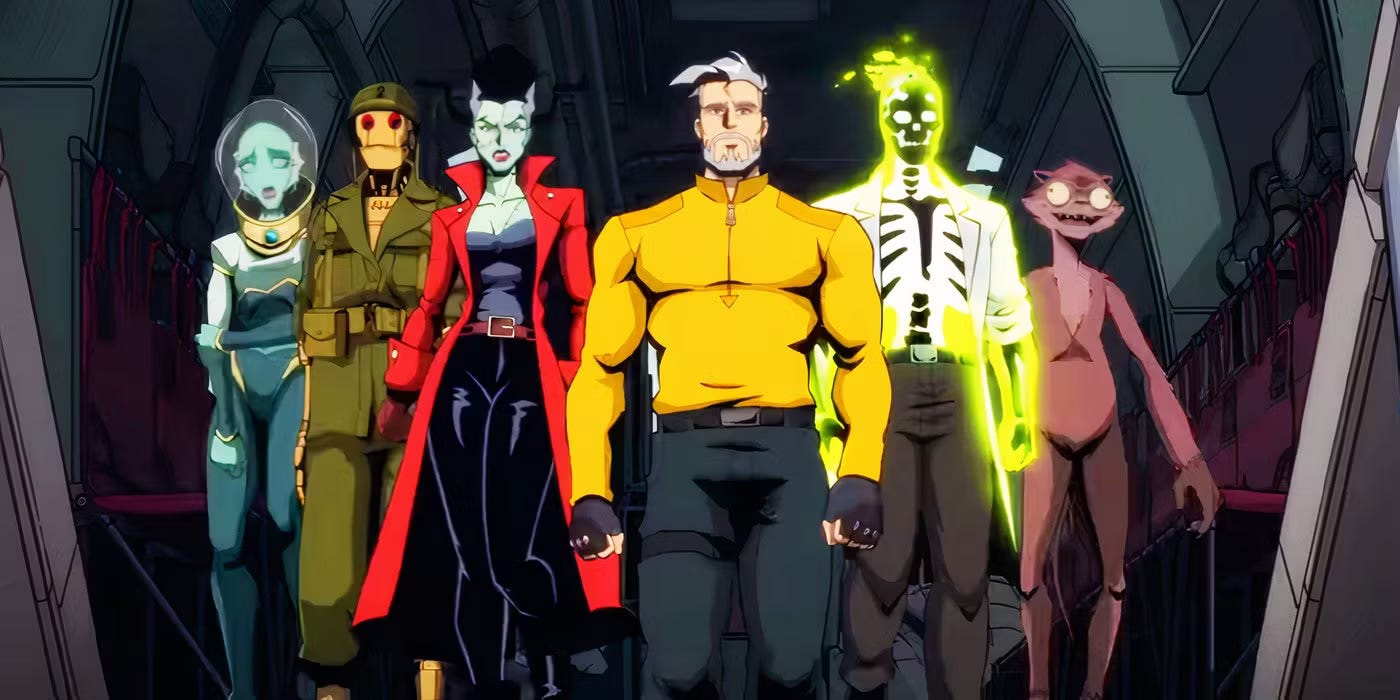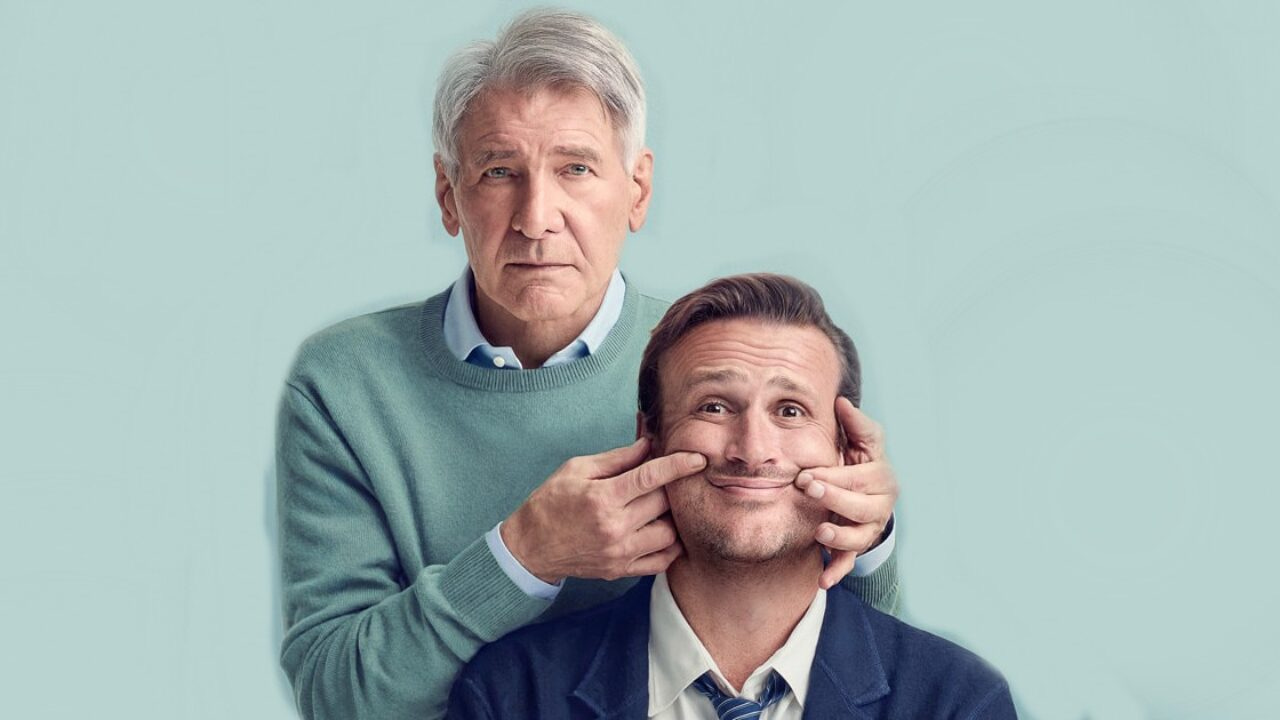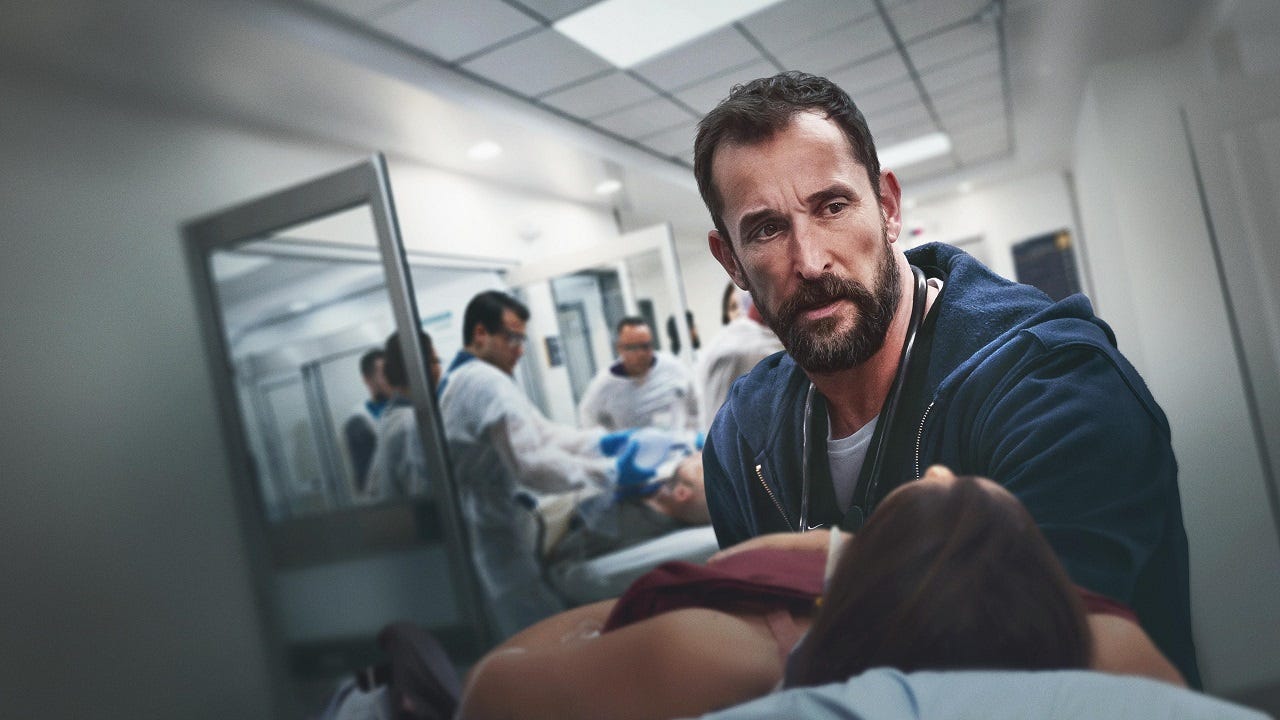Catching up with “Shrinking,” superheroes, “The Pitt” and Jerry Springer
Streaming grabs my attention during a slow time for films.
I’m bad at watching TV.
I consume shows very slowly. I can’t watch more than two episodes of an hour-long drama in one sitting; if it’s a half-hour comedy, I might do three. I watch a few regular programs based around current events, like Last Week Tonight, and I might put on an episode of The Simpsons after a long day. But I try to go to bed at a reasonable time, which means I don’t spend late nights watching TV. And because movies are my main focus, series usually take a backseat to something that gets through its narrative in two hours.
The best time for my TV viewing is actually right after Christmas, when the crush of awards bait has subsided and there’s not much in theaters. I recently got a tablet, so I’ve spent the last few weeks finally doing some bingeing. I finished season two of Girls5Eva (this show deserves to be a massive hit, but yet I realize my dawdling is part of the problem). My wife and I finally got through season three of The Bear (I don’t understand the whining; it was solid) and made some headway on Season 2 of Only Murders in the Building (we were shocked to realize two seasons have come and gone since we last watched an episode). I also have finally started watching The Chosen, which I’ll write about at some point.
But there were a few things I watched that I thought were worth mentioning, maybe not as full-length posts themselves, but as part of a digest of some TV I’m enjoying. So, enjoy this little detour to the small screen.
“Shrinking” grows creatively
I really liked the first season of Shrinking, but I wasn’t completely sold.
The Apple TV+ series, created by Brett Goldstein, Bill Lawrence, and Jason Segel, began as a dark, concept-driven story about Jimmy (Segel), a grieving therapist whose unconventional methods cause chaos but also yield surprising results, much to the dismay of his mentor Paul (Harrison Ford). Initially centered on Jimmy’s struggles and patient interactions, the show soon evolved into a heartfelt ensemble comedy, exploring subplots like Paul’s Parkinson’s diagnosis and Jimmy’s relationships with coworkers, including Gaby (Jessica Williams). By the finale, its charm lay in the character dynamics, though a dramatic twist raised concerns. Season 2, however, resolves these with finesse, shifting focus to the cast’s chemistry and character growth, with standout moments, including a nuanced appearance by Goldstein.
Shrinking has evolved into a true ensemble show, allowing its talented cast to shine. Harrison Ford, initially used sparingly in season one, steps fully into the fold, delivering some of his best work yet — balancing comedy and drama effortlessly and providing both the season’s most moving moment and its biggest laugh. Jason Segel remains a strong anchor with his signature mix of hangdog charm and over-eager energy, while Jessica Williams brings wit and depth as Gaby navigates family challenges. Christa Miller’s unmatched withering humor is on full display, and Ted McGinley steals scenes as the ultra-chill Derek, blending comedic ease with surprising dramatic moments. Together, the cast elevates Shrinking into a rich, dynamic series.
Shrinking shares Ted Lasso’s hopefulness, even if it’s a tad more crass and slightly darker. Yes, it’s about the power of therapy, but it’s more interested in the healing power of community. I love these characters, and I love watching them banter, argue and support one another. It’s a show that makes you want to lean on your friends a little more – or, even better, be there for them to lean on. In Shrinking, everyone is struggling, but the joy of it is that they struggle together. It’s a beautiful and very funny show, and I hope more people check it out before its third season.
Shrinking is streaming on Apple TV+.
Animated superheroes aren’t just kids’ stuff
I don’t watch a ton of animated shows, and I actually have fallen out of watching most superhero TV. But I wanted to give James Gunn’s Creature Commandos a shot because it’s the first official entry in Gunn’s DC Universe and its premise seemed too weird to pass up.
The show is an animated sequel of sorts to Gunn’s The Suicide Squad, following Rick Flagg Sr. (Frank Grillo) as he takes over a secret battalion following his son’s death in that movie. Because Amanda Waller (Viola Davis) is no longer allowed to use human subjects as mercenaries, she gets the next best thing – monsters. Flagg commands a team comprised of the Bride of Frankenstein, a World War II Nazi-killing robot, a fish lady, a sentient weasel and a skeleton man whose touch can melt anything. They head to a foreign country to protect its leader from assassination.
Creature Commandos is not a Saturday-morning cartoon. It’s a big, gory, R-rated adventure that – as you might expect from Gunn – packs subversive humor and a surprising amount of heart. These characters are true monsters, but they also bicker like siblings. And the series’ flashback structure allows Gunn to flesh out one character each week, saddling them with tragic backstories that endear them to viewers. It might not be the most epic start to Gunn’s universe – and maybe that’s a good thing – but the animation is fun, the soundtrack is amazing and I cared about these monsters a lot more than I anticipated. I blew through this entire series.
I enjoyed Creature Commandos so much that I decided to go back and continue watching Marvel’s X-Men ‘97. I’d started the season with my son over the summer, but he seemed fairly disinterested. I was a fan of the X-Men cartoon – of which this is a continuation – as a kid, so I’d always intended to go back and finish, but time got away from me.
I’m kind of glad my son didn’t finish the series, as X-Men ‘97 quickly gets a little more intense and grown-up than he can handle. Not in the same manner as Creature Commandos – the show is still PG/PG-13 adjacent – but the action gets fairly intense (the stakes are high and there’s at least one major character death) and the themes grow deeper, all while the show goes to very weird and very comic book places. As with the best X-Men stories, it examines themes of prejudice and tolerance and how to combat them. But there’s also a soap opera-esque streak where one character is having a telekinetic emotional affair with his wife’s clone.
It sounds silly, but the mix of politics, cosmic-scale stories and relationship dilemma is what has always made X-Men great, and this is a fantastic way to bring them into the MCU fold. Without the demands of realism that live action puts on things, the stories can be as big, strange and crazy as the creators dare, and the animation is zippy and fun. Honestly, this might be one of my favorite things the MCU has ever done, and while I know this will never happen, I wouldn’t be too upset if Marvel just decided that all its X-Men stories would be animated.
I’ve said before that I think animation continues to be the best venue for superhero stories because they honor the medium in which these characters debuted and they’re only limited by imagination. There’s a reason why Spider-Man: Into the Spider-Verse is arguably the best superhero movie ever made and why Batman will never top The Animated Series (I know there’s a Batman animated show on Amazon, and you better believe it’s on my list). Christopher Reeve might be the most iconic Superman, but I don’t know if the character has had more memorable adventures than in the old Fleischer cartoons. And with X-Men ‘97 and What If…?, Marvel has proven that maybe this is the best way to create their universe. It won’t happen, but I can’t imagine a better way to let these stories grow.
Creature Commandos is streaming on Max and X-Men ‘97 is streaming on Disney+.
Digging through the trash of ‘Jerry Springer’
When Jerry Springer died in 2023, I saw more than a few people try to reclaim his reputation, stating that despite the fights, The Jerry Springer show was a triumph because it gave marginalized audiences a voice.
All respect to the dead, but that’s bullshit. Jerry Springer’s program was an exploitative piece of trash, a pandering to our culture’s worst instincts that set the stage for the crassness of Donald Trump. It was gross, vile programming, a program that only rivaled Oprah in the ratings because of its geekshow aspect.
Netflix’s two-part documentary series, Jerry Springer: Fights, Camera, Action, kind of acknowledges the show’s wretchedness – the producers interviewed are happy to admit that they were involved with a sleazy endeavor. But there’s a chuckle beneath their admissions that doesn’t sit well; it too often feels like revelling in what they got away with, with performative remorse so they don’t come off as total monsters.
Despite both episodes running a combined 90 minutes, the documentary feels too long yet also too rushed. It sprints through Springer’s political and journalistic background, and its focus on the show’s quick evolution from mediocre talk show to trash extravaganza feels obligatory, never quite delving into an “aha!” moment when they realized wallowing in filth might elevate ratings. And it’s quite possible there was no moment like that; one central figure in the documentary is producer Richard Dominick – a tabloid veteran who revels in his sleaziness – and it’s suggested the show’s pivot to debauchery was his idea. But there’s also the sense that the show is skipping over anything of relevance to get to the clips of batterings and boobs that were Springer’s stock in trade.
The documentary’s first half chronicles the show’s rise, and it’s probably the most substantial and engrossing bit, as the producers discuss how they sought out the most sordid stories – yes, the man who married a horse gets a shoutout – and then brought guests to Chicago, plyed them with booze and then goaded them into anger before pushing them on stage. This is when the documentary seems most interested in the nuts and bolts of how the program worked, although I wish there were more guests profiled. The second part delves into the controversies that accompanied the show – including Springer being caught in a threesome with the show’s guests, a murder that was linked back to the show, and the national outrage over the program’s content. The documentary hits the big points and stories but its pace is too quick to delve too deep. This is especially harmful when trying to understand Springer’s thoughts on anything or any personal details that could shine a light on him; obviously, he’s not around to defend himself, but the doc seems eager to absolve him of much complicity other than to accuse him of tossing up his hands and saying “what can I do?” Although, in his defense, Springer was very open about the fact that his show had no redeeming value
For those who were around in the ‘90s and remember Springer-mania (I watched a few shows; it was catnip for a teen), Fights, Camera, Action delivers a sort of curdled nostalgia – like being able to smell your old gym socks. My biggest reaction to seeing clips of the show was not to laugh at their outrageousness but to feel sad because I remember how captivated we were by this show – which was fake at its best, exploitative at its worst. The Jerry Springer Show was trash, and I’m not quite sure why we’re not hiding our complicity from our kids. But if you want to know how it all came together and fall apart, this is mildly entertaining.
Jerry Springer: Fights, Camera, Action is streaming on Netflix.
“The Pitt” revitalizes the medical drama
I loved ER. Every Thursday night through the ‘90s, I sat with my parents and thrilled to the panic-inducing drama and cringe-causing carnage. When I tired of ER in the aughts, it was replaced by 24, whose real-time conceit further upped my anxiety levels (this might be worthy of a discussion with a therapist).
And so, The Pitt feels like it was tailor made from me. Co-created by R. Scott Gemmill, who worked on ER, executive produced by John Wells and starring Noah Wyle, it feels about as close to a revival of that show as we’re likely to get. And because the entire season covers one shift in a Pittsburgh hospital’s emergency department, with each episode devoted to an hour, the 24 comparisons are inevitable.
Wyle is ER director Dr. Michael "Robby" Rabinavitch, who is beginning his shift as the show begins. It’s shaping up to be a busy day – the waiting room is always crowded at 7 a.m. – and it’s also the four-year anniversary of the death of Robby’s mentor to COVID. It’s also the day when the student residents are beginning their rotations. Throughout the day, they’ll deal with a variety of patients, whose issues range from the potentially fatal to the ludicrous.
I’ve watched the two episodes currently available to stream (the show’s released every Thursday at 9 p.m. – just one hour off from the ER time slot). I can safely say that unless there’s some massive dip in quality, I’m in for the season. The show is a slightly slower-paced version of ER (a show that moved faster than many others), but that DNA is definitely in there. There’s the shocking carnage and heart-wrenching twists, but also a robust sense of humor and a focus on the staffing and budgetary concerns crippling health centers.
Robby is a bit more grizzled and cynical than Dr. Carter was, but Wyle is still a wonderfully empathetic and engaging actor. The various residents and nurses are still coming into focus, but the cast is fun and there’s enough personality seeded in for me to be curious about where this is all heading. The real-time focus isn’t much of a concern – there’s no looming deadline or time-sensitive catastrophe (yet) – but by limiting the season to one day, it allows the show to focus on the same patients filling the ER.
I’m definitely eager to see more of this, and it was really tempting to not just watch another episode of ER (also available on Max) when I ran out of new episodes of The Pitt. It’s nice to have some medical television-induced anxiety back in my life.
The Pitt is streaming on Max.










I hate all these reboots and nostalgia plays, and I was ready to completely dismiss X-Men '97. And God, it just... nailed it. So hard. I was incredibly moved by the fidelity to the original but also the contemporary shifts in perspective and the more complex evolution of themes addressed decades ago. I was simply mad about it, it was just a perfect object, and for people who like that kind of stuff, that NEVER happens.
Fromtheyardtothearthouse.substack.com